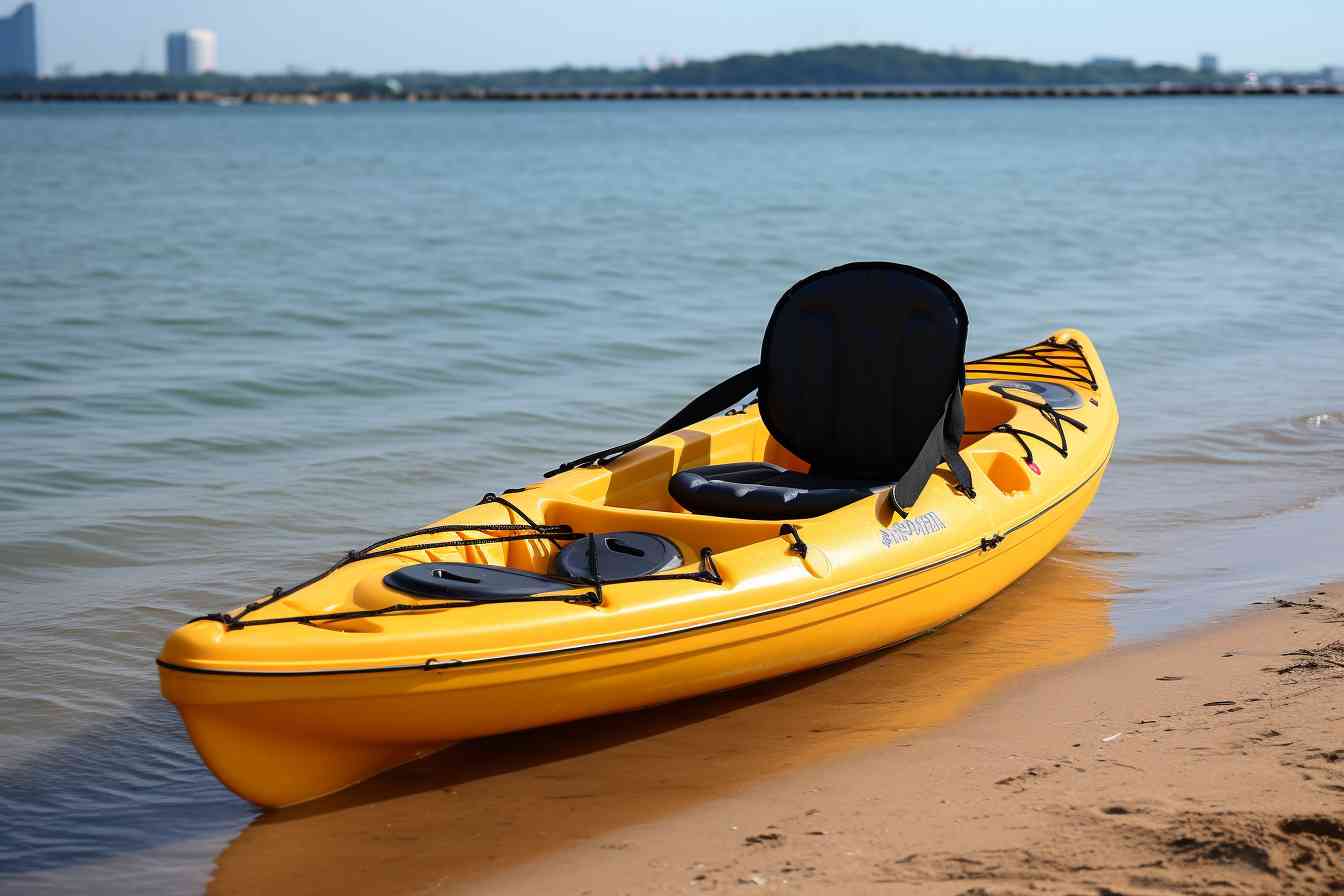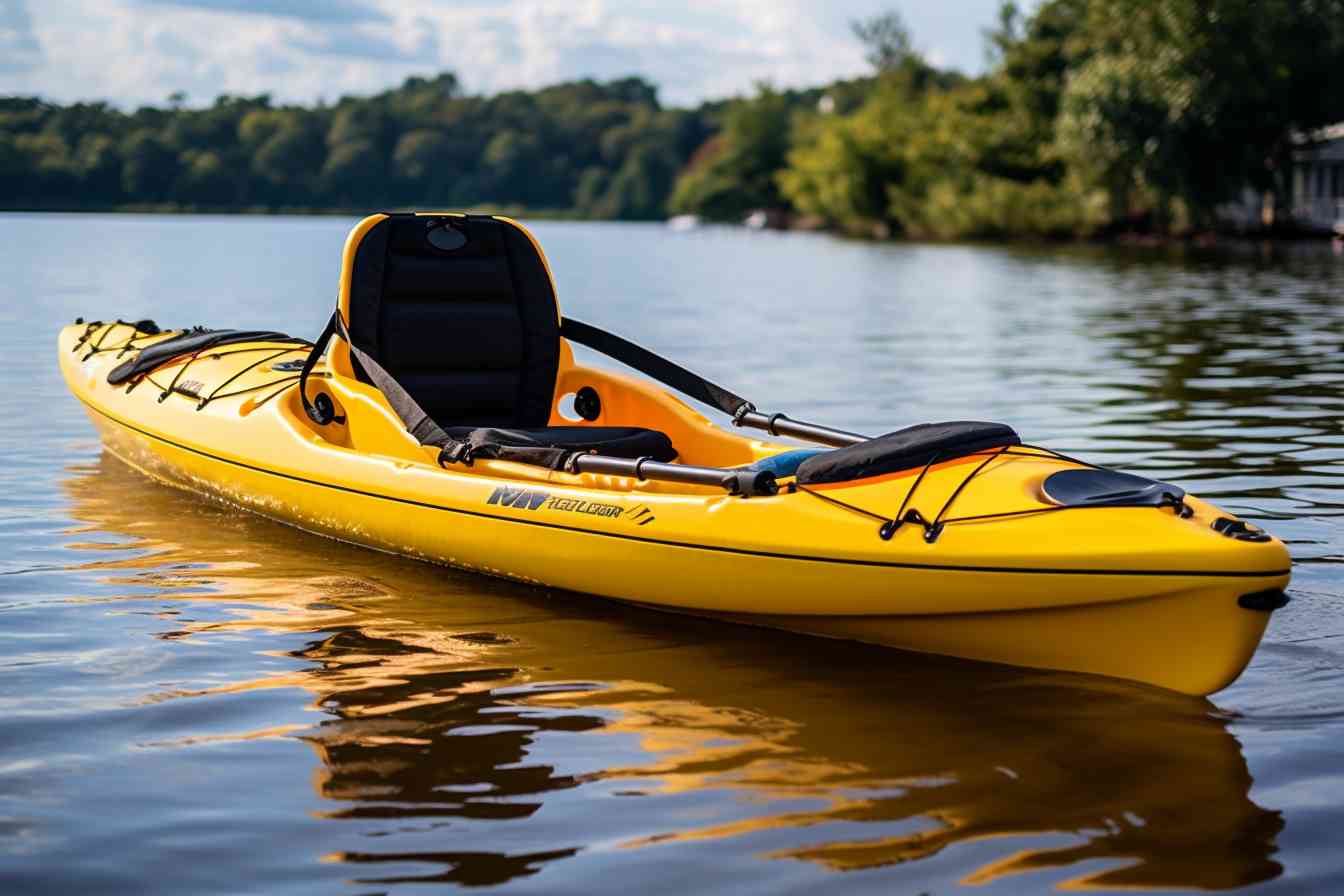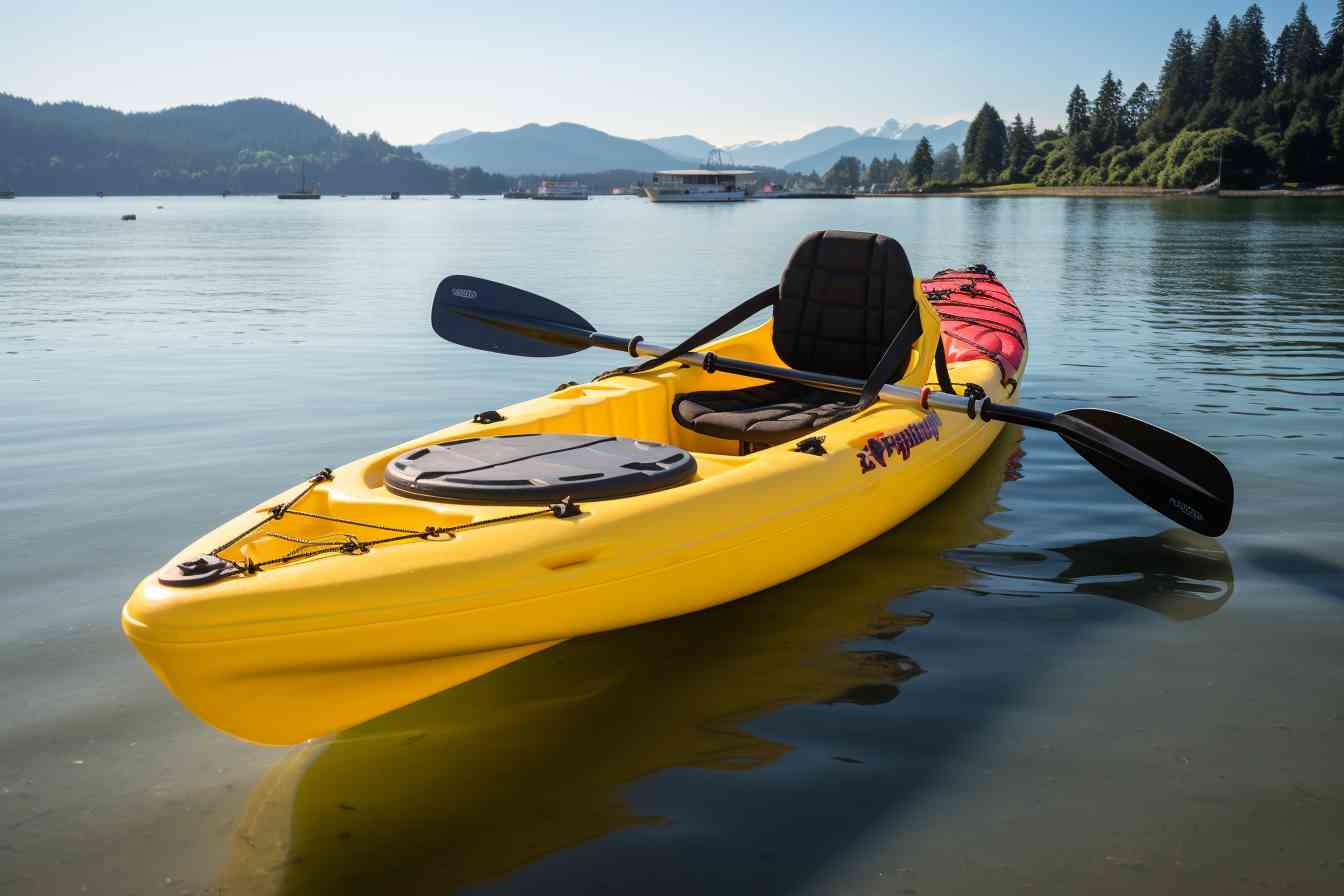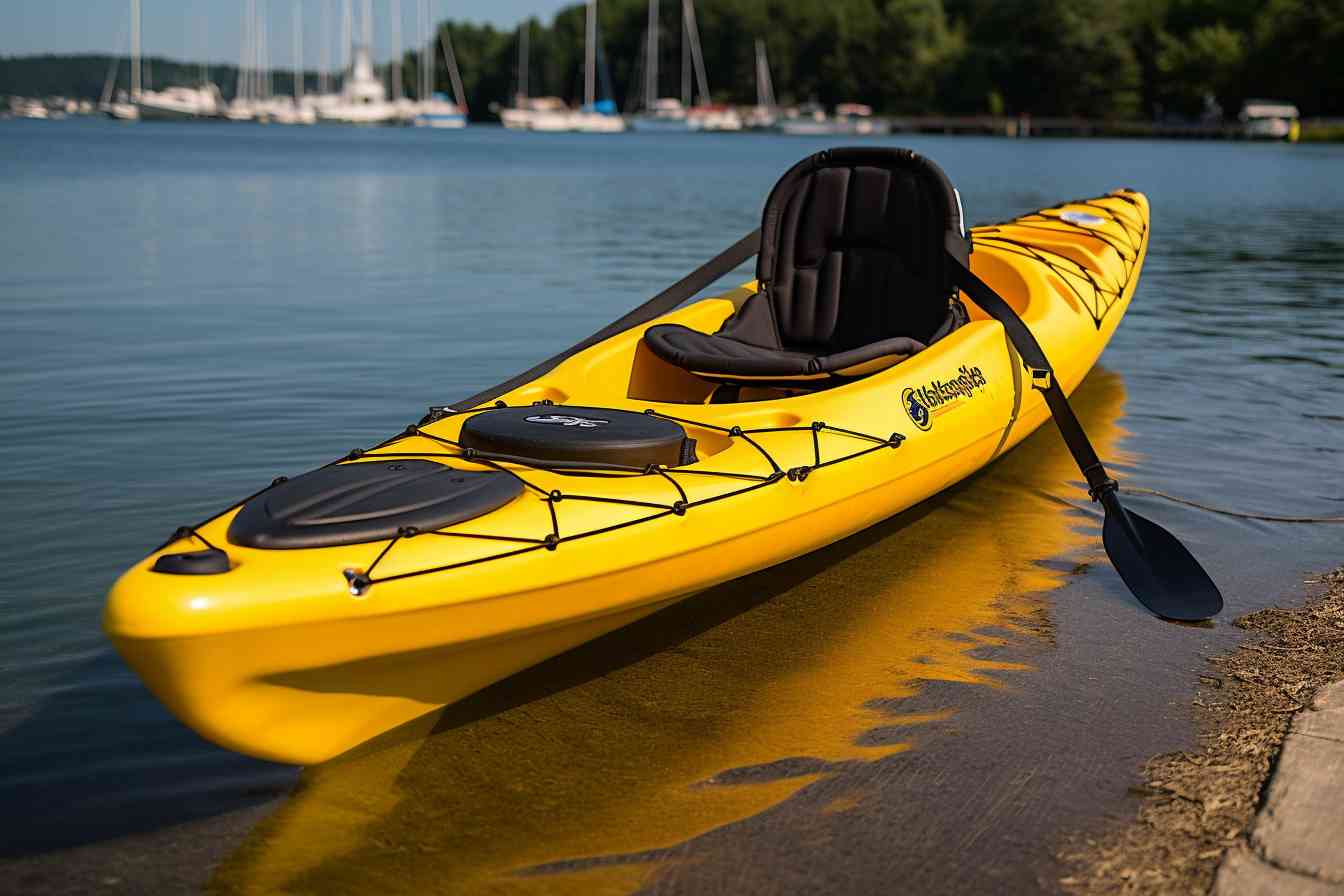Intro: Types Of Kayaks

Boy, am I excited to talk about the different types of kayaks! I don’t know about you, but there’s something about being on the water that just soothes my soul, you know? There are actually quite a few different styles of these sleek watercrafts, each with its own advantage and specific purpose. Let’s dive right in, shall we?
First off, we’ve got recreational kayaks. These are the ones you might see down at your local lake or pond, perfect for relaxed days spent paddling and soaking up the sunshine. They’re usually wide, stable, and easy to navigate – great for beginners or casual paddlers.
Next up, touring kayaks. These puppies are built for the long-haul – think extended trips on open waters. With their length and streamlined shape, they’re designed for efficiency, allowing you to cover more ground (or should I say, water) with less effort.
The sit-on-top kayak is another type that’s especially popular among fishermen and swimmers. It’s user-friendly and self-bailing, meaning any water that splashes in will drain right out. Its stability makes it a superb watercraft for newbies or those who are a tad anxious about capsizing.
And how can we forget about whitewater kayaks? These tiny, nimble vessels are designed to tackle rapid waters with aplomb. They’re shorter and more maneuverable than their counterparts, perfect for weaving through tight spots and riding the waves.
Lastly, we’ve got the sea kayaks – the ocean conquerors, if you will. With their longer length and sharper bow, they’re designed to slice through waves and withstand choppy conditions. They usually have a rudder or skeg to aid in direction control, making them ideal for those ocean expeditions.
Well, folks! That’s a quick rundown of the various types of kayaks. Each one’s got its own charm, but all of them offer the promise of adventure on the water. So tell me, which one tickles your fancy?
What Are The Three Types Of Kayaks?

Well, friends, it’s high time we paddled our way into the exciting realm of kayaking, don’t you think? Now, there’s quite a variety when it comes to these water-friendly vessels – they’re as diverse as the thrill seekers who ride them. But let’s not get swept up in the current; we need to understand the basic types of kayaks first. And there are three! Three types that rule the roost – recreational kayaks, touring kayaks, and whitewater kayaks.
Dive with me into the tranquil waters of recreational kayaks – they’re the perfect choice for calm lake or river adventures. Friendlier to beginner paddlers, they possess a wider beam (that’s width to you and me) and are therefore more stable. They’re often sporting a larger cockpit for easy entry and exit. Their only downside? They’re not keen on long trips or high speed – they’re more about enjoying the scenery and taking it easy.
Now, if you plan on being a bit more adventurous and cover decent distances over open water, then you might want to consider touring kayaks. Dolling up with sleeker and longer designs, these speed demons cut through water like a hot knife through butter! Their narrow beam makes them less stable but hey, that’s where the fun lies, right? They also come with rudders or skegs to aid in control. The adventurers among us love these bad boys!
Finally, we have the daredevils’ favorite – the whitewater kayaks! Designed to handle rapid, turbulent waters, these adrenaline-inducing vessels are shorter, with a curved bottom and edges that make them highly maneuverable and ideal for tricks. Jumping off waterfalls, anyone? They require advanced paddling skills, but oh, are they worth the thrill!
So, what’s your cup of tea? Are you a serene sightseer, a distance conqueror, or a rapids wrangler? Regardless, there’s a kayak out there just waiting for you!
Types Of Kayaks With Pedals
Well, I gotta tell you – I’m a huge fan of pedal kayaks! They’re excellent for those who prefer hands-free operation or are looking to get a fantastic leg workout. Let’s break down the different types of kayaks with pedals, shall we?
-
Recreational Pedal Kayaks: These are designed for calm waters like lakes and slow moving rivers. They’re typically wider for added stability, making them perfect for beginners or those looking for a leisurely paddle.
-
Tandem Pedal Kayaks: These are simply pedal kayaks designed for two people, a great option for couples or friends who like to paddle together. Differences in strength between the two paddlers can be offset with individual pedal systems.
-
Fishing Pedal Kayaks: Specifically designed for anglers, these come equipped with features like rod holders, tackle storage, and anchor systems. The hands-free operation allows fishermen to concentrate on their line rather than paddling.
-
Touring Pedal Kayaks: These are designed for longer trips on larger bodies of water. They’re typically sleeker and faster than other types, with plenty of storage for gear.
-
Inflatable Pedal Kayaks: Perfect for those with limited storage or transportation options. These are easy to inflate and deflate, and can be stored in a small space when not in use.
[SUBHEADINGS]: Kayaks with push pedals
When it comes to pedal kayaks, there’s another division to note: push pedals versus rotational pedals. Let’s dive into push pedal kayaks, which often offer great power and maneuverability.
-
Hobie Mirage Drive Kayaks: These are perhaps the most known when it comes to push pedal systems. The unique “Mirage Drive” system mimics the motion of a penguin’s flippers for efficient movement in the water.
-
Pedal and Paddle Kayaks: Some kayaks offer the versatility of both a push pedal system and traditional paddles. This is handy for those who want the option to switch between pedaling and paddling.
-
Low Profile Pedal Kayaks: Certain styles of push pedal kayaks have a lower profile, reducing wind resistance on open water. This is especially beneficial for longer trips or windy conditions.
-
High-Seating Pedal Kayaks: Some models feature high seats that allow for a better vantage point and less water splash. This can make for a more comfortable paddling experience.
-
Hybrid Pedal Kayaks: These are a blend of traditional paddle kayaks and pedal-powered ones. Hybrid models allow for the versatility of switching between pedal power and paddle power, great for varying conditions or just to mix up your workout.
What Is The Most Popular Type Of Kayak?

Well, alright! If you ask me about popularity, I’d have to say the sit-on-top kayak takes the cake! Heap of folks seem to gravitate toward these, and I reckon there are a few reasons why. First off, they’re by far the easiest to use. Perfect for beginners dipping their toes in the water, so to speak.
You see, sit-on-tops are a pretty stable bunch, especially when compared to their sit-in buddies. You run less risk of tipping over, and even if you do, there’s no struggle to get out and flip the kayak back over. That’s a sweet deal, especially for those more anxious about taking a spill.
Plus, these kayaks are designed with a self-draining system. That’s right, any water that gets in, drains right out. Moses himself couldn’t part the sea any quicker! And did I mention how easy it is to climb back on if you go for an accidental — or intentional — swim?
However, not everything is peaches and cream. For instance, one drawback to the sit-on-top is that you’re more likely to get wet from splashing water. But c’mon, who doesn’t love a refreshing splash here and there? Plus, you’ll be out in the open, so bring that sunscreen! You’ll need it.
Some folks might say other models could be more popular, perhaps the touring or inflatable versions. But trust me, for sheer ease and fun, a sit-on-top kayak can’t be beaten. Remember, the best kayak is the one that suits your needs and keeps you paddling! Don’t be swayed by fancy jargon or shiny new features. Find what you’re comfortable with and hit that water! It’s your adventure, after all.
Types Of Kayaks For Beginners
Oh, the exciting world of kayaking! It’s an incredible sport that gets you up close and personal with nature while giving you a good workout. But before you jump into the water, it’s important to understand the different types of kayaks that are best suited for beginners.
- Sit-On-Top Kayaks: These are the most beginner-friendly. With a stable design and an open cockpit, you’re less likely to capsize, which makes it an excellent choice for your first ventures into the water.
- Recreational Kayaks: Known for their stability and ease of use, recreational kayaks are another great choice for beginners. They are best used on calm waters like lakes and easy flowing rivers.
- Inflatable Kayaks: Don’t be fooled by their lightweight build, inflatable kayaks are surprisingly sturdy and resistant. Plus, they’re easy to transport and store, perfect for anyone just starting out.
- Tandem Kayaks: Starting your kayaking journey with a partner? Then a tandem kayak might be perfect for you. With room for two paddlers, you can ease into the sport with a friend or with an experienced kayaker.
- Touring Kayaks: While slightly more advanced, touring kayaks can build a beginner’s confidence on the water. They’re designed for longer journeys, so they’ve got the space to pack food and gear for a longer excursion.
Then there are a few other options that you might want to consider as your skills improve and you gain more experience on the water.
- Sea Kayaks: As the name suggests, these are designed for sea conditions. They are typically longer and narrower than other types, which takes a bit of practice to handle. But they offer a unique and exciting kayaking experience.
- Whitewater Kayaks: Got a thirst for adventure? Whitewater kayaks are designed to handle fast, turbulent rivers. These may require more skill, but they can provide an exhilarating ride.
- Fishing Kayaks: If you love fishing and want to mix in some kayaking, fishing kayaks are a popular choice. They have extra features like rod holders and storage spaces for tackle and equipment.
Kayaking is a personal journey, and there are a variety of vessels to help you on your way. Start with a beginner’s kayak and gradually work your way up as you build confidence and skill. It won’t be long before you’re gliding on the water like a pro. Paddle on, my friend!
What Type Of Kayak Is Best For Beginners?

Sure, I reckon we all gotta start somewhere, right? So, for beginners lookin’ to dip their toes in the water—or, shall we say, paddle in the lake—a few types of kayaks are particularly fitting. Boy oh boy, do I remember my first time trying to navigate through those waves. Seemed like a monster task back then, but let’s not get sidetracked.
The recreational kayak is a dreamboat for beginners. It’s got a wide hull (that’s the main body part of the kayak, in case you’re wondering!), and it means it’s nice ‘n stable. It’s like having training wheels on your bike. Just looking at these kayaks, I can’t help but admire their simple elegance. And you know what they say, simplicity is the ultimate sophistication.
They’re shorter, lightwheight so it’s easy to manage and have an easy entry and exit openings called cockpits if you didn’t knew already – the bigger the cockpit, the easier it is to get in and out. Also, in a happy turn of events, they’re usually much cheaper than the other types—kinda like a cherry on top, eh?
On the other hand, there’s the sit-on-top kayak. It’s an open design where you sit on top rather than inside. They’re popular for leisurely paddles and fishing and are particularly good for those warmer climates. But be mindful, you may get a bit wet from the paddle splash. Ah, the joy of splashing around in the water on a sunny day – it doesn’t get much better than this!
Remember, everyone’s got a different pace. No need to rush and no need to boast about being the fastest. We all enjoy the water in our own way, and that’s the beauty of it. Just pick the kayak that you feel most comfortable with and you’ll be set to become a bona fide paddler. Ain’t that the dream?
So, my fresh paddlers, what are you waiting for? You’ve got a basic understanding of the beginner-friendly kayaks now. Go ahead, pick your poison, hit the water… and get paddling! It’s the first step to a lifetime of aquatic adventure, and trust me—it’s a step well worth taking. You’ll find nothing feels quite like commanding your own vessel across the tranquil majesty of a glassy lake. Happy paddling, my friends!
What Is A Type 2 Kayak?
Alright, let’s dive straight into the subject – Type 2 kayaks. Now, you’ve probably heard folks throwing around different terms like Type 1, Type 2, Type 3 kayaks, and you’ve been left wandering in the dark. Don’t fret because I’m about to shed some light on this mystery. Type 2 kayak is not a standard term we generally use to classify kayaks. It’s a bit of a fabled creature, if you will, and it’s not often on the tips of people’s tongues when they’re discussing kayak varieties.
Still, if we’re going to talk about Type 2 kayaks, we must think about the context. A common occasion people refer to this term is when discussing kayak related safety courses. Here, Type 2 is often used to denote a certain water condition that would test your paddling skills. Rougher than Type 1 condition but not as treacherous as Type 3, it’s the mid-level challenge for kayakers.
But, if you’re thinking of a particular kayak style labeled Type 2, I’m hard-pressed to give you a straight answer. Kayak types typically have names like “white-water,” “sea,” “recreational,” or “touring.” There is no universally agreed upon classification system that labels them numerically.
So, if anyone ever asks you about a “Type 2” kayak, feel free to ask for a bit more clarity. The world of kayaking is full of unexpected turns and twists, and nomenclature is certainly one of them. Keep paddling and keep learning, that’s the way to master this engrossing sport.
Final Verdict
Well, let’s cut to the chase and talk about the grand finale – the final verdict! I’ve been paddle-deep in the kayak universe for a while now, and let me tell ya, it’s quite an impressive panorama.
There are two typos of kayaks that really reign supreme – recreational and sea kayaks. Recreational kayaks are casual, user-friendly, and, well… just plain fun. These are your go-to for those leisurely weekends on a placid lake, the kind where your biggest challenge is deciding whether to bring the cooler with sandwiches or the one with cold drinks.
Sea kayaks, on the other hand, are the long-distance runners of the water world. They’re designed for braving the elements, whether it’s riding the waves or cruising across a vast expanse of water. This typos of kayak brings forth a sense of adventure and challenging the unknown, kind of like I felt the first time I came face-to-face with a rapid.
But that doesn’t mean there aren’t other contenders worth mentioning! Whitewater kayaks for the adrenaline-chasers, fishing kayaks for the anglers out there, and the tandem kayaks for those who enjoy company – it’s like there’s a kayak for every persona and every mood!
In the end, the right kayak for you depends on your needs, preferences, and the type of adventure you’re seeking. Like I always say, “The best kayak isn’t the one in the guide, it’s the one in the water with you!”
Well, there you have it folks – the final verdict. I hope this helps to clarify the wide world of kayaks for you. Happy paddling!
Frequently Asked Questions
Q1: What are the different ?
Well, there are several but the most common ones include recreational kayaks, touring kayaks, sea kayaks, whitewater kayaks, and fishing kayaks. Each type is designed for a specific purpose and has different characteristics.
Q2: What distinguishes a recreational kayak from the rest?
Recreational kayaks tend to be wider, more stable, and easier to maneuver. They’re the perfect pick for casual paddling and fishing on calm waters. Think of them as your relaxing weekend getaway.
Q3: How does a touring kayak differ from a recreational kayak?
Touring kayaks, my friend, are longer and narrower. They are built for longer distances on larger bodies of water. They’re more challenging to navigate but offer a fabulously rewarding paddling experience and impressive speed.
Q4: What makes a sea kayak unique?
Well, sea kayaks are designed specifically for seawater. They possess a long, sleek design for speed and tracking. Plus, they often come with rudders or skegs to help with steering in current or windy conditions. Adventurous, huh?
Q5: What is a whitewater kayak?
Whitewater kayaks are shorter, allowing for quick, responsive turns. They are designed specifically for river rapids. These kayaks definitely offer a thrill ride!
Q6: Why should I consider a fishing kayak?
Ah, fishing kayaks, they’re a pure joy! They’re stable, have ample storage for your fishing gear, and are equipped with rod holders. Perfect for a leisurely day of fishing, wouldn’t you say?
Q7: Is there a type of kayak designed for two people?
Yes, indeed! The tandem kayak is typically designed to seat two people. Perfect for when you want to share the paddling or simply enjoy the company.
Q8: Are inflatable kayaks a good option?
Oh absolutely! They’re portable, easy to store, and surprisingly durable. They might not be as fast or smooth as hard-shell kayaks, but they are a great option for casual paddlers.
Q9: How does a sit-on-top kayak compare to a traditional one?
With a sit-on-top kayak, you sit on top rather than inside. They’re stable, easy to get in and out of, and are perfect for warm climates. A refreshing change from the traditional, right?
Q10: What is a crossover kayak?
Crossover kayaks are a blend of touring and whitewater designs. It’s like getting the best of both worlds, offering versatility for those who like to mix up their kayaking adventures. Sounds exciting, doesn’t it?

